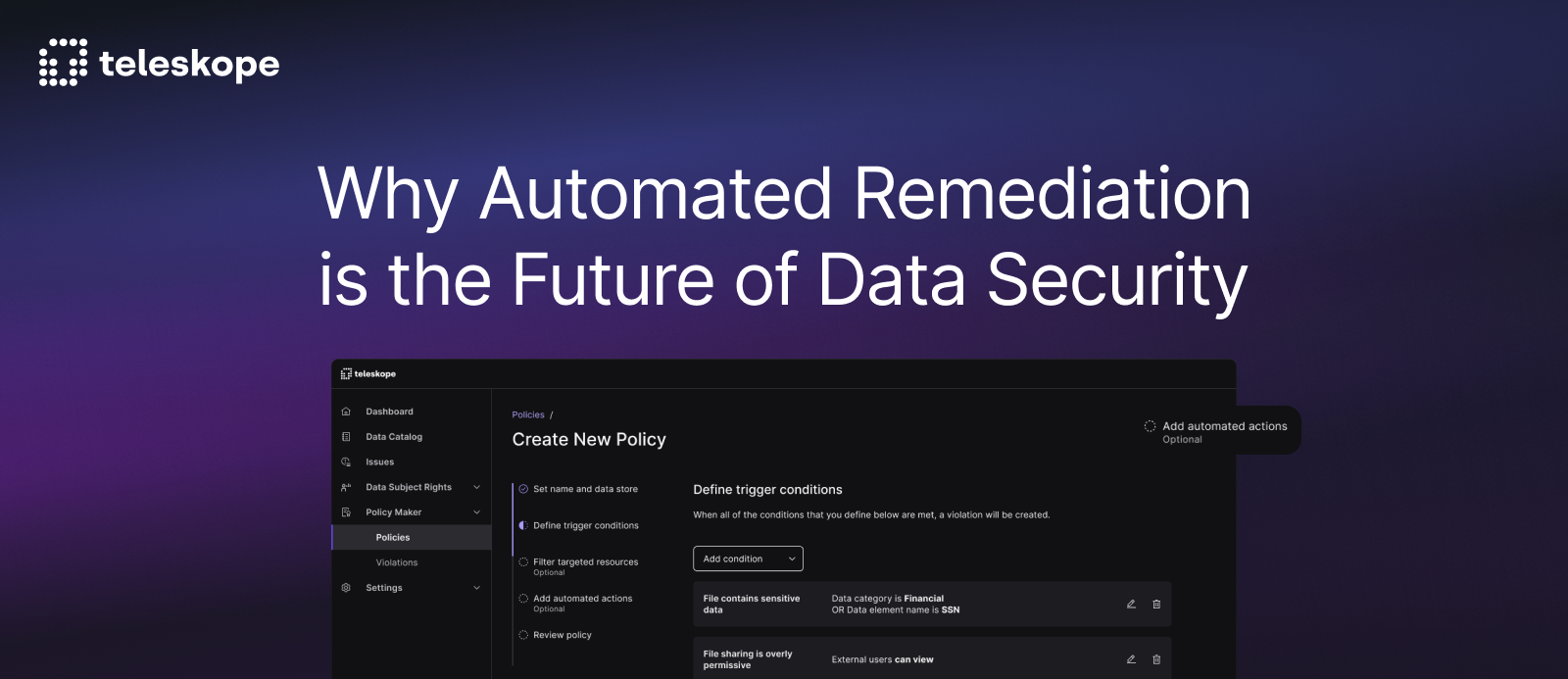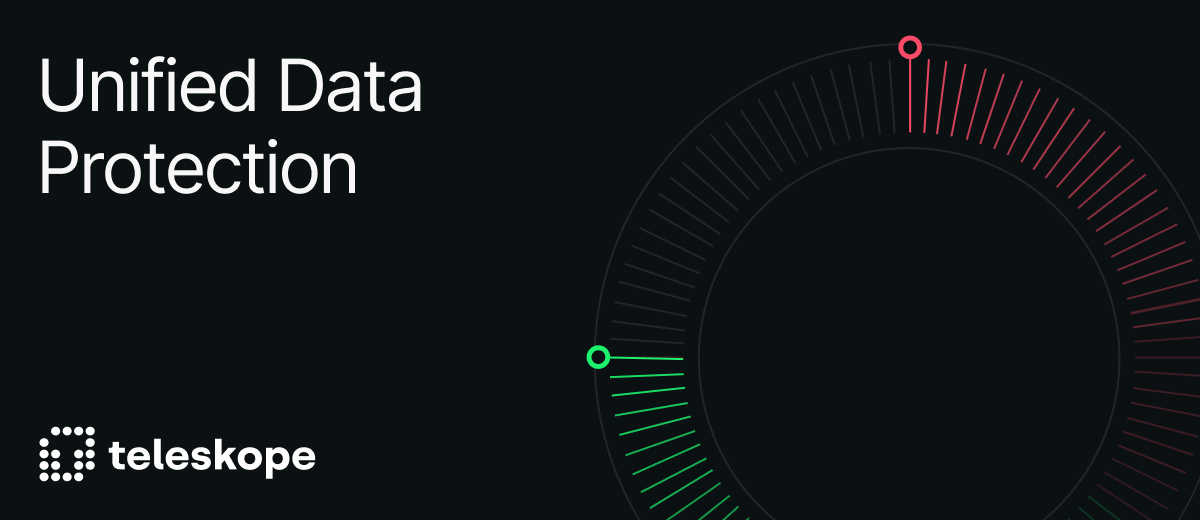Why Automated Remediation is the Future of Data Security
Insights

In an era where security teams are drowning in dashboards, noisy alerts, and fragmented analytics, visibility without action has become a liability, it surfaces problems without solving them.
Some security leaders may balk at this take. After all, knowing where sensitive information lives and who has access to it is fundamental to any modern data protection strategy. However, amid growing industry labor shortages, increasingly advanced attacks, and a data environment that’s expanding by 400 million terabytes per day, visibility without timely and scalable remediation workflows is simply a half-measure.
At Teleskope, we believe AI, when applied appropriately, offers an opportunity to build a scalable data security program that finds and addresses risks as they arise. By embracing these innovations, security leaders can shift from reactive enforcement to proactive protection that effortlessly scales alongside modern data environments.
The Visibility Trap in Modern Data Security
In conversations with security leaders across finance, healthcare, consumer tech, and other industries, one theme comes up again and again: data discovery and classification is always the starting point for any security strategy.
And we agree. Before you can protect sensitive data, you need to know where it resides, what it is, what it contains, who it pertains to, who has access to it, how it’s stored, and what risks surround it. However, security leaders often get caught in the visibility trap, leaning on multiple solutions to achieve this first step, but failing to invest in scalable remediation to close the loop..
To paint a clearer picture of the visibility trap, let’s zoom in on the people operating at the forefront of data security: SecOps and InfoSec analysts. For these contributors, visibility is rarely confined to a single pane of glass. They may rely on a DSPM tool to gain a baseline view of their data footprint, but it’s typically supplemented with point solutions covering narrow domains: SaaS visibility in Google Workspace or Microsoft 365, structured data discovery in AWS, or internally developed tools for on-prem file storage.
Each of these systems relies on unique configurations to detect and classify data, which means they often deliver conflicting results. The outcome is a patchwork view of the data footprint, with context switching, false or duplicative alerts, and configuration management consuming hours of an analyst’s time while still only providing partial visibility.
Then comes the issue of remediation. For infosec analysts, remediation is far from straightforward; it’s the daily grind of enforcing policy controls to remove risky permissions, revoking access for unauthorized users, encrypting sensitive data in exposed storage buckets, and quarantining files that violate compliance policies like GDPR, SOC 2, or PCI-DSS. Because most data security tools don't offer automated remediation flows out of the box, analysts are frequently left to act on data risks manually, leading to perpetual alert backlogs, prolonged data vulnerabilities, and heavy burnout.
“Even when you know where the issue is, you’re still relying on someone to go in, revoke access, or move the data. That’s why so many alerts just sit — it’s not automated, and teams don’t have the bandwidth to do it all manually.” — Eric Peterson, Principal Security Consultant at New Era Technology
In modern data environments, where new risks can emerge hourly, visibility without fast, reliable remediation leaves organizations exposed, drains resources, and diminishes the impact of even the broadest DSPM deployments.
The Impact of Visibility Without Scalable Remediation on Security Teams
For today’s analysts, having a disparate stack of data visibility solutions while relying on manual remediation workflows can feel like trying to shovel in a snowstorm.
But don’t just take our word for it. We asked Eric Peterson, Principal Security Consultant at New Era Technology, to share his firsthand account of how visibility without automated remediation impacts the daily workflows of security teams.
Speaking from over a decade of experience working in data security for leading companies like Oracle and Wells Fargo, Eric breaks down the typical analyst’s day-to-day below:
Log On and Navigate the Noise
For most professionals, logging on to a backlog of emails is a common occurrence. For analysts, however, they log on to a dashboard filled with overnight alerts, such as an externally shared file in a Google Drive containing PII, a misconfigured S3 bucket exposing PCI data, or an internal SharePoint folder with overly permissive access. Each alert is pulled across a patchwork of visibility solutions into a ticketing queue for the analyst to address.
“Blue teams are always going to be behind, inundated with alerts, and experiencing alert fatigue. There are always too many alerts in the SOC, and most of the time, everybody just handles everything as it comes in.”
Put Your Detective Hat on for Your First Ticket
After assessing their priorities for the day, the analyst will open their first ticket, let’s say it surrounds access to an exposed folder containing PII. However, Eric shares that before they can even address it, the analyst must verify the classification (false positives are common when detection rules aren’t finely tuned). That means pulling metadata, cross-referencing with asset owners, and checking compliance requirements such as GDPR or SOC 2. Eric emphasizes that each of these tasks can take hours on average.
Start the Lengthy Remediation Process
After verifying the classification and confirming the ticket isn’t a duplicate or false positive, the analyst manually revokes access to the exposed folder — a task requiring coordination with IT, a policy exception request, and a follow-up audit. Eric highlights that cross-coordination between these teams can be tricky and time-consuming, as each has their own priorities and daily workflows to complete.
Find Time to Put Out Another Fire
Speaking from experience, Eric explains that escalated alerts often land mid-workflow and require immediate attention. For example, an analyst might uncover a stale database containing PHI that’s out of compliance with retention policies. Since most DSPMs can’t enforce deletion or apply retention policies directly, the analyst has to manually export the records, notify the data owner, trigger a deletion request through a separate privacy tool, and update audit logs, all while pausing the original remediation task.
Rinse and Repeat
The process repeats: assess → investigate → fix → document. With alerts arriving through email, messaging platforms, ticketing systems, and dashboards, context switching becomes constant.
By day’s end, only a fraction of the queue is cleared. High-priority items remain in the backlog, not because they’re underprioritized, but because the remediation process itself is slow, fragmented, and dependent on too many human handoffs.
The result?
- Ticket backlogs that never fully clear
- Delays that extend risk exposure windows from hours to weeks
- Analyst fatigue from chasing repetitive, manual tasks
“You really don’t have a single pane of glass to see or do everything. You can see it, but you can’t action it. That’s the gap — and it’s why remediation at scale is still the hardest part.”
Our Thesis: Automated Remediation is the Only Way to Enforce Data Protection at Scale
So, how can security leaders help their teams close the gap between identifying data risks and streamlining the actions needed to solve them? The answer is simple: automated remediation.
DSPM tools have, to a large degree, solved the visibility problem in modern data security, though the accuracy and scalability of many tools remain questionable. Now, security leaders need to turn their focus (and budget) toward remediating risk at scale, turning visibility into tangible reductions in data risk.
Consider a common scenario: a security team discovers hundreds of thousands of sensitive files sitting in S3 buckets where they don’t belong. Traditionally, an analyst would have to manually validate each flagged file, confirm the classification, and then move or encrypt those files in small batches, a process that can take weeks and is prone to error.
With Teleskope’s Prism classification engine and policy-driven remediation, the process looks very different:
- Prism validates file context by assigning document category tags to confirm whether flagged data is truly sensitive.
- Automated policies then move or quarantine all misclassified files at once, ensuring they are stored only in safe, approved locations.
- Instead of double-checking each document manually, analysts can approve a single policy and trust that every current and future violation of that type will be remediated in near-real time.
No context switching, no prolonged exposure window, and no backlog. When visibility and remediation operate in tandem, they empower security leaders to move from passive monitoring to real-time and scalable protection.
The moment a risk is detected, whether in a SaaS app, cloud data store, or on-prem system, automated workflows can:
- Revoke access for unauthorized users
- Remediate low-risk misconfigurations before they escalate
- Redact sensitive data elements shared in SaaS platforms like Slack, Zendesk, or Teams in near real time
- Quarantine sensitive or noncompliant data to prevent exposure
This shift not only accelerates response times from hours to seconds, it also frees up human analysts to focus on high-impact investigations and strategic initiatives. It’s the difference between firefighting and fire prevention.
The impact of automated remediation isn’t conceptual. A recent report found that automated remediation can lead to a 90% decrease in critical vulnerabilities. Another study revealed that the median resolution time for an automated remediation action hovers around 15 minutes, whereas manual workflows can easily exceed 2 hours. That’s an 87.5% reduction in response and resolution times. And with Teleskope, validating and approving an action on a potential violation takes less than a minute, while fully automated remediation requires mere seconds to act.
How We Built Teleskope to Help Security Leaders Shift to Proactive Data Protection
Many data security tools stop at surfacing risks, leaving the responsibility for triage and remediation to already-stretched security teams. Teleskope is the first solution built to address both sides of the equation at scale, unifying precise visibility and automated remediation in a single platform.
By combining these capabilities, Teleskope eliminates the need for teams to stitch together multiple point solutions just to achieve baseline protection. It integrates seamlessly into existing environments, from SaaS applications to multi-cloud deployments to on-prem systems, with minimal setup.
At the core of the platform is Prism, Teleskope’s data classification pipeline, which combines multiple models with layered post-validation steps to ensure accuracy. Prism can classify both structured and unstructured data across SaaS, cloud, and on-prem environments, validating not only what the data is but also the business context around it. Whether it’s customer PII in a SaaS CRM, PCI data in a cloud storage bucket, or PHI stored in an on-prem database, Teleskope pinpoints exactly where sensitive information resides and who can access it.
From there, Teleskope applies automated remediation policies that deploy when violations or risks are detected. Depending on the nature and severity of the issue, the platform can revoke unauthorized access, quarantine sensitive or noncompliant assets, redact data in-line, encrypt exposed data, or execute other targeted policy controls. All of this happens without manual intervention, shrinking remediation timelines from hours to seconds while reducing operational drag on security teams.
When human oversight is necessary, Teleskope’s one-click approval workflows make it easy for analysts to review context-rich policy violations and approve actions without having to go to the data source for a prolonged investigation.
The result is a faster, more confident security posture — one where teams can resolve issues at the source without slowing operations or introducing workflow friction.
“Teleskope gives us what we need today — and they’re building fast toward what we’ll need tomorrow. That’s the kind of partner we want to grow with.” — Security Leader at Ramp
Strengthen Your Data Protection Strategy With Teleskope
Gone are the days when security leaders could rely on fragmented visibility tools alone to protect sprawling data footprints. As attack surfaces grow and manual workflows fail to keep pace, organizations that combine real-time visibility with automated remediation will not only survive in modern data environments, but thrive.
If you’re currently relying on a patchwork of visibility tools and manual remediation workflows, book a call with Teleskope to close the gap between analysis and action.
Introduction
Kyte unlocks the freedom to go places by delivering cars for any trip longer than a rideshare. As part of its goal to re-invent the car rental experience Kyte collects sensitive customer data, including driver’s licenses, delivery and return locations, and payments information. As Kyte continues to expand its customer base and implement new technologies to streamline operations, the challenge of ensuring data security becomes more intricate. Data is distributed across both internal cloud hosting as well as third party systems, making compliance with privacy regulations and data security paramount. Kyte initially attempted to address data labeling and customer data deletion manually, but this quickly became an untenable solution that could not scale with their business. Building such solutions in-house didn’t make sense either, as they would require constant updates to accommodate growing data volumes which would distract their engineers from their primary focus of transforming the rental car experience.
- list
- list
- list
- list
Continuous Data Discovery and Classification
In order to protect sensitive information, you first need to understand it, so one of Kyte’s primary objectives was to continuously discover and classify their data at scale. To meet this need, Teleskope deployed a single-tenant environment for Kyte, and integrated their third-party saas providers and multiple AWS accounts. Teleskope discovered and crawled Kyte’s entire data footprint, encompassing hundreds of terabytes in their AWS accounts, across a variety of data stores. Teleskope instantly classified Kyte’s entire data footprint, identifying over 100 distinct data entity types across hundreds of thousands of columns and objects. Beyond classifying data entity types, Teleskope also surfaced the data subjects associated with the entities, enabling Kyte to categorize customer, employee, surfer, and business metadata separately. This automated approach ensures that Kyte maintains an up-to-date data map detailing the personal and sensitive data throughout their environment, enabling them to maintain a structured and secure environment.
Securing Data Storage and Infrastructure
Another critical aspect of Kyte’s Teleskope deployment was ensuring the secure storage of data and maintaining proper infrastructure configuration, especially as engineers spun up new instances or made modifications to the underlying infrastructure. While crawling Kyte’s cloud environment, Teleskope conducted continuous analysis of their infrastructure configurations to ensure their data was secure and aligned with various privacy regulations and security frameworks, including CCPA and SOC2. Teleskope helped Kyte identify and fortify unencrypted data stores, correct overly permissive access, and clean up stale data stores that hadn’t been touched in a while. With Teleskope deployed, Kyte’s team will be alerted in real time if one of these issues surfaces again.
End-to-End Automation of Data Subject Rights Requests
Kyte was also focused on streamlining data subject rights (DSR) requests. Whereas their team previously performed this task manually and with workflows and forms, Kyte now uses Teleskope to automate data deletion and access requests across various data sources, including internal data stores like RDS, and their numerous third-party vendors such as Stripe, Rockerbox, Braze, and more. When a new DSR request is received, Teleskope seamlessly maps and identifies the user’s data across internal tables containing personal information, and triggers the necessary access or deletion query for that specific data store. Teleskope also ensures compliance by automatically enforcing the request with third-party vendors, either via API integration or email, in cases where third parties don’t expose an API endpoint.
Conclusion
With Teleskope, Kyte has been able to effectively mitigate risks and ensure compliance with evolving regulations as their data footprint expands. Teleskope reduced operational overhead related to security and compliance by 80%, by automating the manual processes and replacing outdated and ad-hoc scripts. Teleskope allows Kyte’s engineering team to focus on unlocking the freedom to go places through a tech-enabled car rental experience, and helps to build systems and software with a privacy-first mindset. These tangible outcomes allow Kyte to streamline their operations, enhance data security, and focus on building a great, secure product for their customers.


from our blog

